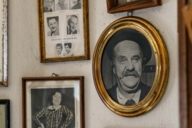
Famous faces from Munich describe their favourite pieces in Munich’s museums and explain just what makes these pieces so special to them.
Milen Till (artist and DJ)
“I first came across this piece by Karl Valentin at the Valentin-Karlstadt-Musäum in Isartor gate back when I was a teenager. My dad showed it to me, along with the melted ice sculpture and the “father and son” umbrellas. In 2009, my dad curated a Karl-Valentin exhibition called “Gestern oder im 2. Stock” (“Yesterday or on the Second Floor”) for the Stadtmuseum (Munich City Museum). “Der Leistenbruch” hangs on the wall in the narrow spiral staircase on the second floor, not far from Valentin’s famous nail, which he used to hang up his previous carpentry career.I think this avant-garde piece is incredibly pioneering because Valentin was one of the first people to recognise humour and absurdity as an art, thereby paving the way for Dadaism and conceptual artists.
"The ,ruptured frame‘ works as a perfect ,Readymade‘. Long before Duchamp! Valentin couldn’t possibly have thought that far ahead, but that makes it all the more interesting."
It fills me both with awe and pure joy, mainly because the ruptured frame – a frame being an essential part of painting along with the canvas – works as a perfect “Readymade”. Long before Duchamp! Valentin couldn’t possibly have thought that far ahead, but that makes it all the more interesting. I always come back to “Leistenbruch”, especially when it’s raining for instance. It’s lovely and cosy up in the museum’s snug café. And my favourite piece is always there so I just keep coming back. Well, until 5.59 p.m. anyway when the museum closes for the day. It’s hard to imagine Munich without Valentin and Valentin without Munich. For me, he is the Municher of the century.”
See it at Valentin-Karlstadt-Musäum
Caroline Link (director)
“During a stroll around the wonderful, newly renovated Lenbachhaus a few years ago, I was captivated by the painting “Wolkengespenster” by Richard Riemerschmid from the year 1897. A full moon, clouds, shadowy figures. A man hunting a woman. Sensual? Menacing? It’s all in the eye of the beholder.
"The painting has an archaic force and reminded me of dreams I’ve had that left me feeling both scared and yet electrified. I love the Jugendstil style (art nouveau)."
The painting has an archaic force and reminded me of dreams I’ve had that left me feeling both scared and yet electrified. I love the Jugendstil style (art nouveau). The way it plays with nature and the subconscious fills me with joy. It forms part of my work as a film maker. Villa Stuck and Lenbachhaus in particular house some incredible examples of work from this period. A postcard of “Wolkengespenstern” sits on my desk, providing me with inspiration as I work on my scripts.”
See it at Lenbachhaus
Ludwig Wappner (architect and urban planner)
“One very special museum in Munich that always has a long-lasting effect on me every time I visit is the Glyptothek museum on Königsplatz square in Munich. My first intensive experience with the museum came during the first few semesters of my architecture degree at Munich Technical University from 1979 to 1985. We visited the museum as part of the ever-popular free-hand drawing course. One sculpture that had an extra strong pull me on, both back then and today, is the elegant and wonderfully sculpted “Barberinische Faun” from around 220 BC, right in the middle of the Hellenism period, which lasted from 323 to 146 BC. The statue stands in the centre of the museum’s western Faun hall.
"Morning is my favourite time to come here. The peaceful surroundings and morning light are the ideal conditions for carefully studying the intricate details and subtlety of this sculpture."
Lit by a central sky light in the dome – not dissimilar to the Pantheon in Rome – the carefully contoured statue stands in the centre of the room with an elegance you are unlikely to encounter anywhere else. Here, space, material, daylight, geometry and aesthetic come together to transform this sculpture into an incredible Gesamtkunstwerk, immediately casting its spell over any interested passer-by. Morning is my favourite time to come here. The peaceful surroundings and morning light are the ideal conditions for carefully studying the intricate details and subtlety of this sculpture.
In addition to the sculptures and the museum’s architecture, it is also worth visiting its famous café, which opens out onto the grand inner courtyard. It’s my insider tip for Munich, particularly in the lunchtime and afternoon sun.”
See it at Glyptothek